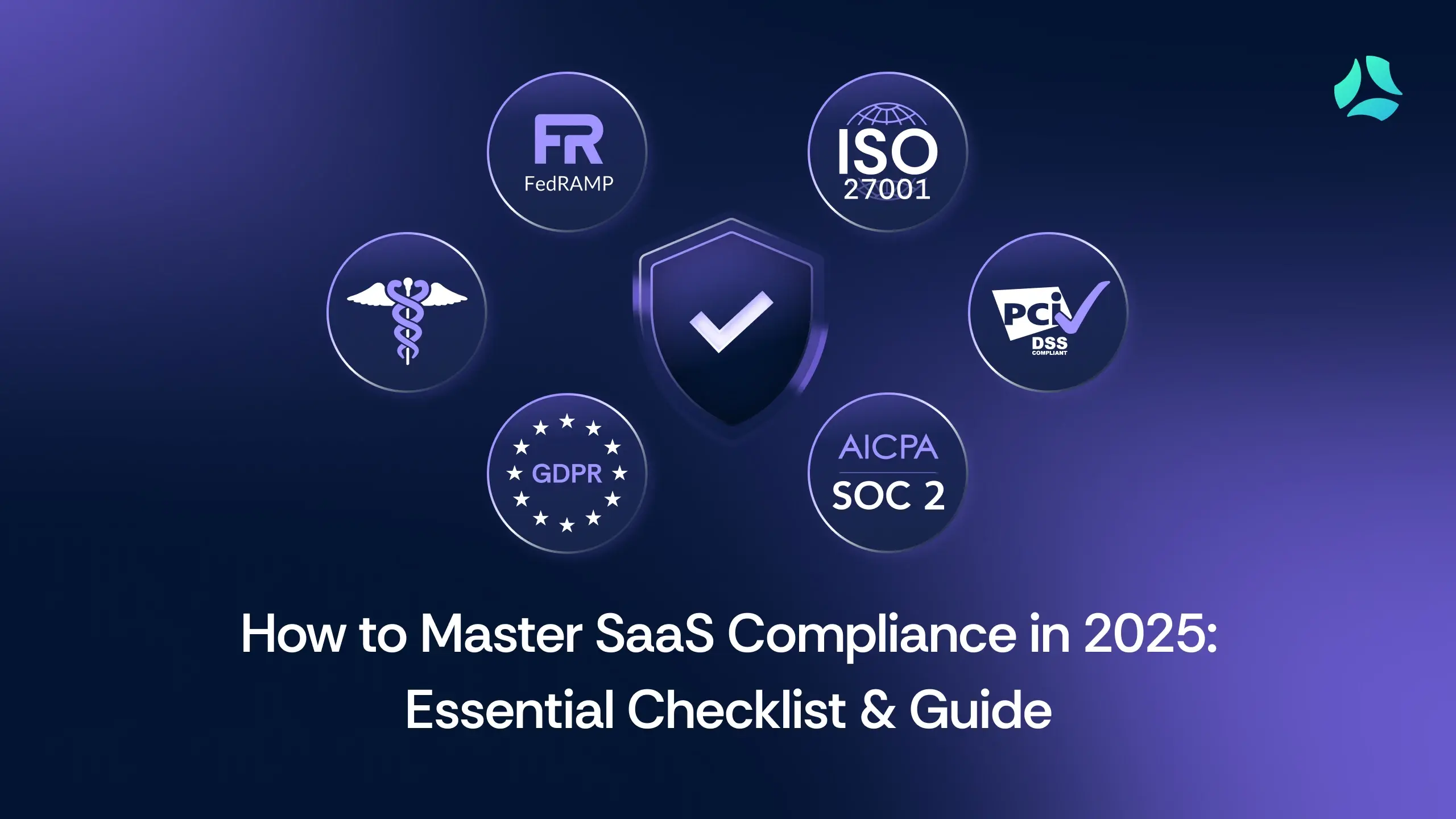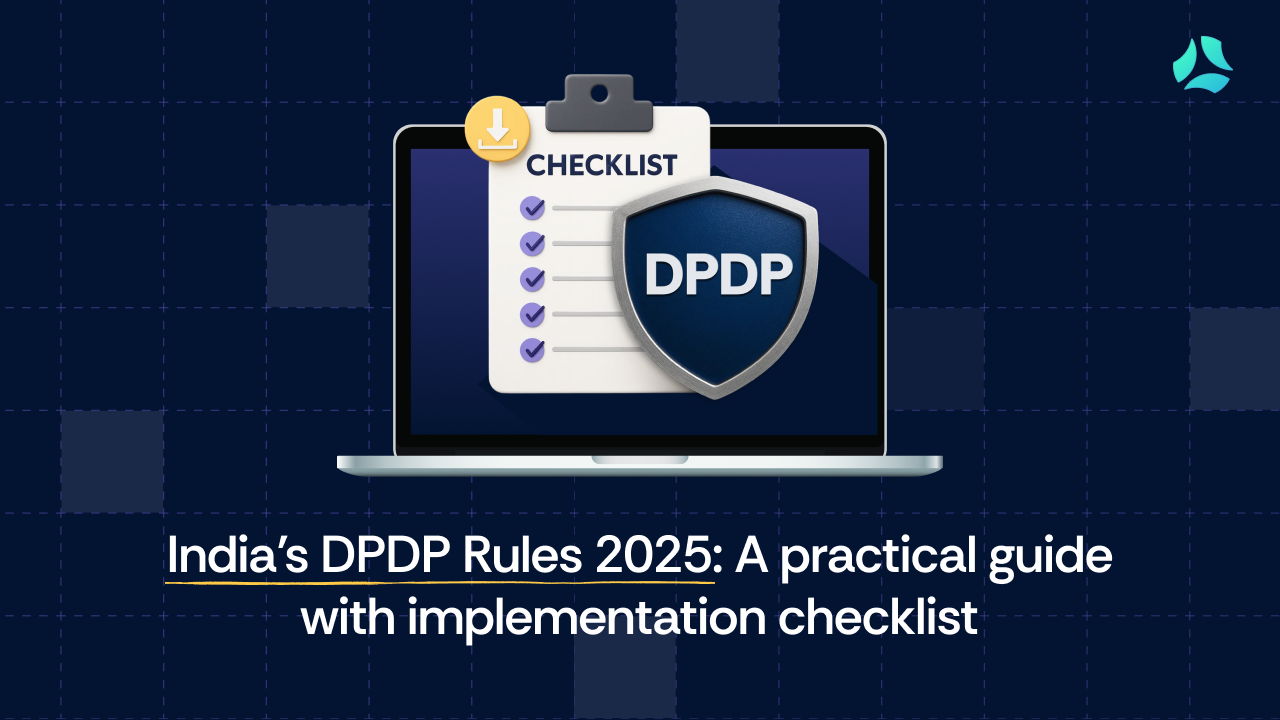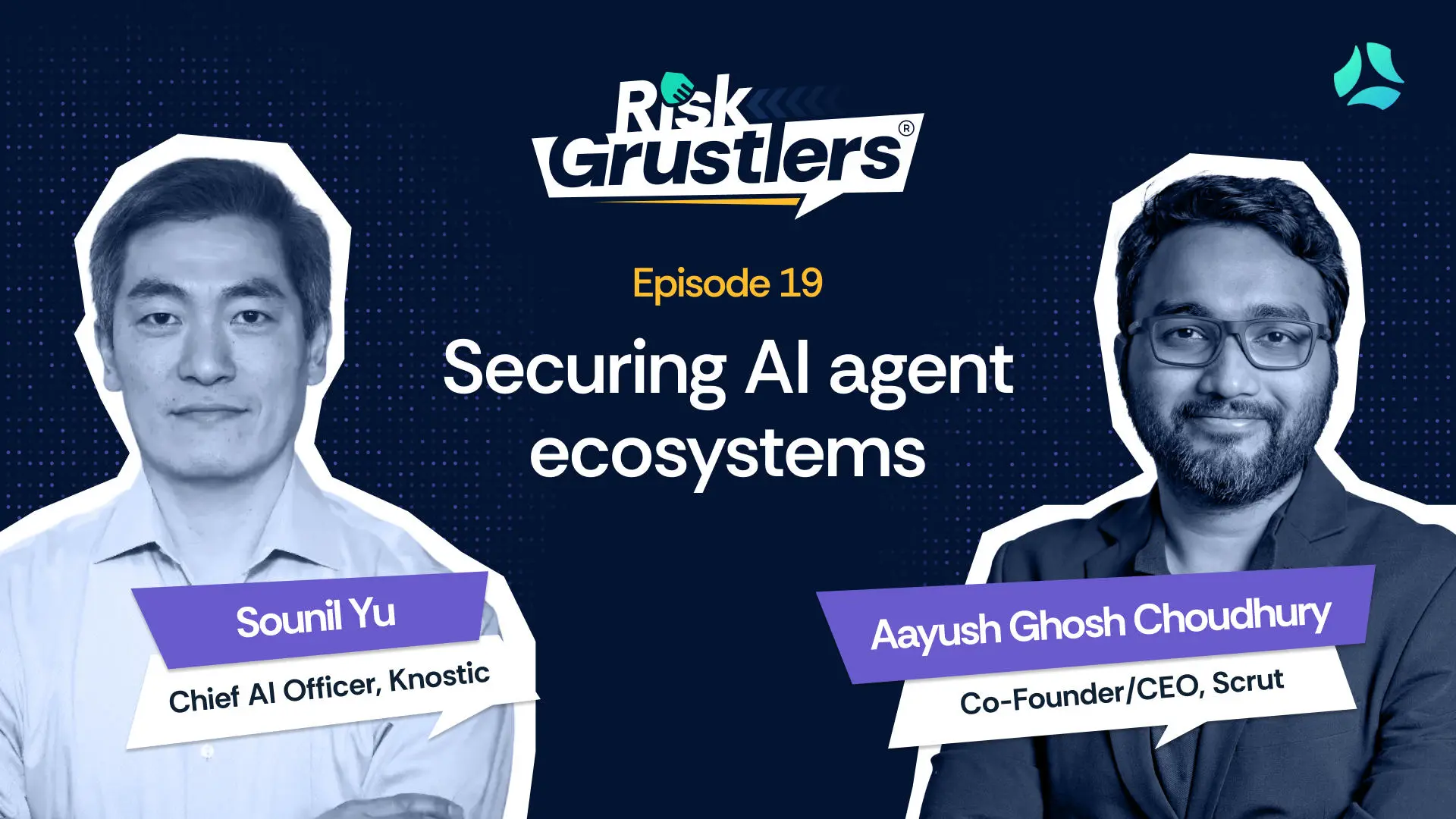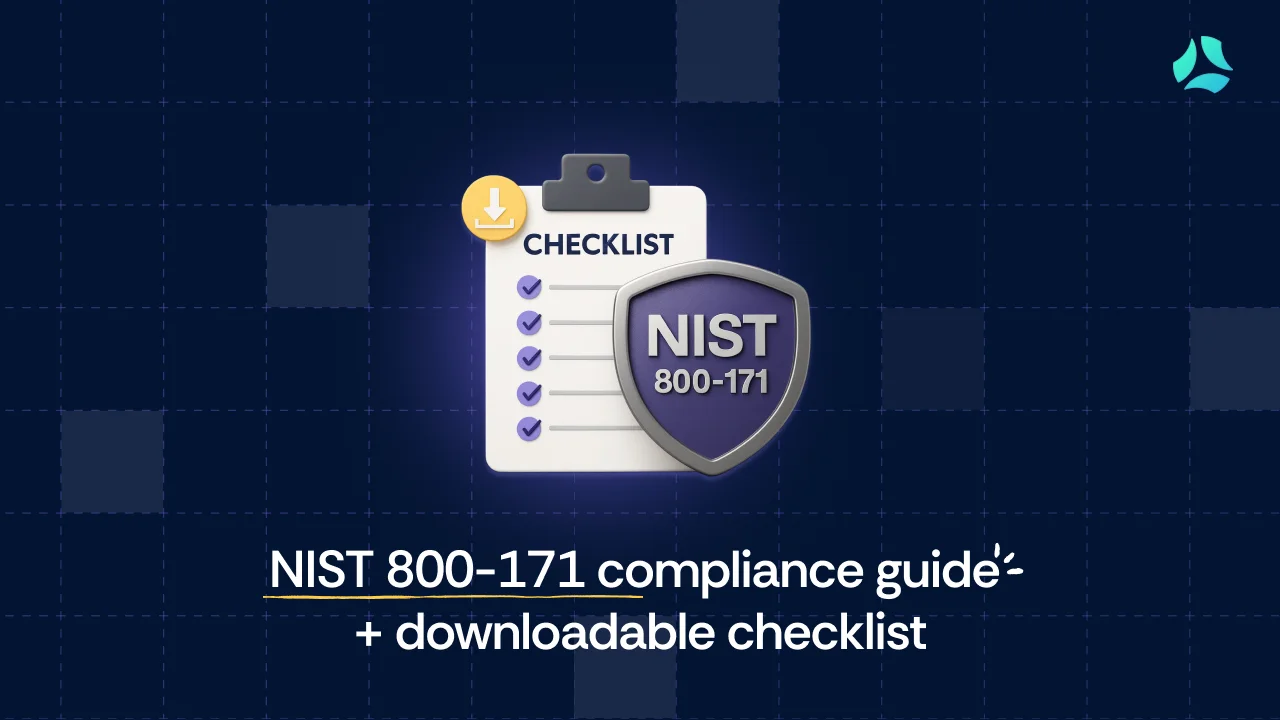How to master SaaS compliance in 2025: Essential checklist & guide

2025 brings unique challenges that make compliance more critical than ever for SaaS businesses. New frameworks, such as ISO 42001 for AI management systems, NIST CSF 2.0 updates, and the full enforcement of the EU AI Act, are reshaping the regulatory landscape. Meanwhile, existing regulations, such as GDPR and CCPA, continue to evolve with stricter enforcement and an expanded scope.
SaaS companies face distinct compliance challenges. For example:
- Multi-tenancy architectures mean customer data often shares infrastructure, creating complex isolation requirements.
- Data residency concerns intensify as customer data may be processed across multiple global regions.
- The shared responsibility model with cloud providers adds another layer of complexity, requiring clear delineation of security and compliance obligations between SaaS vendors and their underlying infrastructure providers.
However, for IT leaders, navigating global regulations while maintaining efficient operations is no small task. As regulations continue to evolve, staying compliant requires a proactive and informed strategy.
This guide offers a clear, step-by-step approach to mastering SaaS compliance in 2025, with practical strategies and best practices to help your business meet compliance standards. By following this guide, you can turn compliance into a strategic advantage.
Most common compliance frameworks for SaaS in 2025
SaaS companies need structured guidelines to establish secure processes and comply with regulatory requirements. Your business needs to know which frameworks apply to stay compliant and keep customer trust.
1. SOC 2 (Type I and II)
SOC 2 has become a market-driven expectation for SaaS companies, focusing on securing customer data across key areas such as security, availability, processing integrity, confidentiality, and privacy.
Without SOC 2, earning the trust of larger customers is difficult, as enterprises often require proof of robust security before considering any contracts. This attestation report demonstrates your commitment to safeguarding data. If skipped, you risk facing longer and more tedious sales cycles, with customers insisting on detailed security audits and questionnaires.
2. ISO 27001
ISO 27001 sets the global standard for establishing, implementing, maintaining, and continually improving an Information Security Management System (ISMS) through a risk-based approach. It’s particularly important for SaaS companies targeting international markets, especially in regions like Europe and Asia, where ISO 27001 is often expected.
This certification demonstrates to auditors that your business systematically identifies, assesses, and addresses security risks. Without it, you might find yourself locked out of lucrative international markets or losing deals to competitors that can demonstrate compliance.
3. HIPAA (For health-related SaaS)
HIPAA compliance is essential for any SaaS company dealing with health-related data, such as patient records or insurance information. It ensures you protect sensitive health data and comply with strict privacy standards to collaborate with healthcare providers and insurers. If you violate HIPAA rules, you risk legal penalties, damaged partnerships, and significant harm to your brand from breaches of sensitive health information.
4. GDPR and CCPA
GDPR and CCPA are key privacy regulations designed to protect individuals' rights over their personal data in EU/EEA and California, respectively. These laws give users control over how their data is used, and your SaaS business must comply. Adhering to these regulations helps you avoid accusations of mishandling, enhances customer trust, and shields your business from regulatory investigations. Failing to comply can result in hefty fines and the loss of customer trust if data is mishandled.
5. PCI DSS (For payment processing)
PCI DSS applies to SaaS platforms that handle credit card payments or store payment information. It ensures the protection of sensitive financial data and maintains secure transaction environments. PCI DSS reduces the risk of payment data breaches, safeguarding both your customers and your business from fraud. If neglected, payment processors might penalize you, increase transaction fees, or even revoke your ability to process payments, which can severely disrupt your revenue streams.
6. FedRAMP (For government-facing SaaS)
FedRAMP is essential for SaaS companies aiming to provide cloud services to U.S. federal agencies. It standardizes the assessment process for government customers, ensuring compliance with stringent security requirements. FedRAMP provides an Authorization to Operate (ATO) or a Provisional ATO (P-ATO) after assessment. This enables easier access to federal contracts, proving your capability to handle sensitive government data securely. Without it, you won’t be able to tap into the federal sector, which is a significant and growing market.
7. ISO 42001 (AI Management System)
ISO 42001 is the world's first international standard for AI management systems, establishing requirements for developing, implementing, and maintaining AI systems responsibly. For SaaS companies integrating AI capabilities into their platforms, this standard is becoming increasingly critical in 2025.
This certification demonstrates your organization's commitment to responsible AI development and deployment, covering areas like AI governance, risk management, transparency, and ethical AI use. As customers and regulators become more concerned about AI risks, having ISO 42001 certification can differentiate your SaaS platform and build trust with enterprise clients who are cautious about AI adoption. Without it, you may face scrutiny about your AI practices and lose deals to competitors who can demonstrate responsible AI management.
8. EU AI Act
The EU AI Act, which came into full effect in 2025, represents the world's most comprehensive AI regulation. For SaaS companies offering AI-powered services to EU customers, compliance with the AI Act is mandatory and carries significant penalties for non-compliance.
The Act categorizes AI systems by risk levels and imposes specific requirements for each category. High-risk AI systems must undergo conformity assessments, maintain detailed documentation, ensure human oversight, and implement robust risk management systems. SaaS companies must also provide clear information about AI system capabilities and limitations to users. Non-compliance can result in fines up to €35 million or 7% of global annual revenue, whichever is higher. For SaaS companies serving EU markets, the AI Act compliance is not optional—it's a business necessity that affects product development, deployment, and customer relationships.
Challenges in SaaS compliance that security teams face
Security teams working in SaaS companies today face a growing list of challenges in maintaining compliance. It’s not just about setting up policies — it’s about managing complex environments, evolving risks, and limited resources, all while the regulatory landscape continues to shift.
Here’s what teams are up against:
1. Managing dynamic environments and shadow IT
In SaaS environments, new apps are deployed quickly, users onboard themselves without oversight, and updates roll out overnight. Shadow IT, where employees sign up for SaaS apps outside official channels, adds even more risk. Security teams often don't know all the apps in use, making it hard to maintain compliance.
Example: An employee signs up for a file-sharing app without IT approval, unknowingly exposing sensitive customer data.
2. Data security and privacy challenges
Data is scattered across several SaaS applications, creating huge governance problems. Tracking how data is collected, stored, shared, and deleted across third-party apps is a significant challenge for security teams, particularly as new privacy laws emerge rapidly across various regions.
Staying on top of this often requires investing in compliance software, region-specific legal advice, and regular system audits.
Example: A marketing app might collect customer data but store it on servers in a region not compliant with local privacy laws, requiring costly remediation efforts or vendor replacement.
3. Distributed ownership across departments
In many companies, different teams manage their own SaaS apps — HR owns one platform, marketing owns another, and finance uses something else. This distributed ownership creates major blind spots. Security teams often lack direct control over all apps, making it more challenging to enforce company-wide compliance standards.
Example: Marketing may forget to turn on two-factor authentication in a CRM platform, leaving a security hole unknown to IT.
4. Risks from third-party vendors
Relying on third-party SaaS vendors brings its own set of risks. Even large, trusted vendors can suffer breaches. Security teams are tasked not only with securing their internal environments but also vetting and monitoring the security posture of every SaaS provider they work with.
Example: A compromised vendor with access to your customer data could result in shared liability — and significant cleanup costs.
5. Resource constraints and time-intensive compliance processes
Compliance is a long, resource-heavy commitment. Security teams, especially in startups or fast-growing SaaS companies, often don’t have enough people or time to manage it all.
And the costs add up fast — from hiring external auditors and legal consultants to investing in tools for data governance and security upgrades. Achieving compliance with SOC 2, PCI DSS, or FedRAMP can take months to over a year, pulling team members away from other critical work and stretching already tight budgets.
Proactively embedding compliance into development workflows may seem resource-heavy upfront, but it prevents costly rework and late-stage retrofits.
Example: Preparing for a SOC 2 audit can take a security team approximately six months, requiring dedicated staff time, third-party audits, and ongoing evidence collection — all of which come with a significant financial burden.
6. Heavy penalties and business risks for non-compliance
Failing to meet compliance standards can bring serious consequences, from heavy financial penalties to long-term reputation damage. Security teams are under constant pressure to get it right because even a small mistake can have major fallout.
Example: Violating HIPAA regulations can lead to fines up to $50,000 per violation, not to mention lawsuits and loss of customer trust.
SaaS compliance checklist: Getting started in 2025
A clear, step-by-step compliance checklist lets you see exactly what needs to be done and keeps your entire team aligned. Follow these stages to move confidently from planning to ongoing assurance.
1. Pin down applicable frameworks
Before any controls or audits, list out the rules that apply to your setup:
- Inventory all data you collect or process (personal data, payments, health records, etc.).
- Match data types, business locations, and customer regions with standards, regulations and frameworks like GDPR, CCPA, HIPAA, PCI DSS, SOC 2, or ISO 27001.
- Bring in a compliance expert or legal advisor to confirm you’ve covered every applicable regulation.
Checklist:
☐ Complete data inventory
☐ Frameworks relevant to your operations identified
☐ Expert review scheduled
2. Score and rank your risks
Identify and prioritize the vulnerabilities that could impact your business the most:
- Group risks into categories—compliance gaps, security threats (e.g., ransomware, phishing), operational breakdowns, third-party exposures, and financial fraud.
- Assign each risk a simple score for likelihood and impact, then focus first on those with the highest combined rating.
Checklist:
☐ All risk categories documented
☐ Scores applied using a risk matrix
☐ Top-tier risks selected for immediate action
3. Run an initial readiness review
Spot gaps before drafting your full strategy or involving auditors:
- Compare existing policies, procedures, training records, and technical setups against each chosen framework.
- Note missing or outdated documentation, untrained personnel, incomplete access controls, and vendor risks.
- Conduct a mock audit—either with your internal team or via an external consultant—to get a realistic snapshot of readiness.
Checklist:
☐ Policy and procedure review completed
☐ Training and documentation gaps logged
☐ Mock audit executed
4. Build your compliance roadmap
Transform findings into a clear action plan that everyone follows:
- For each gap, define the steps needed to close it (policy updates, new training modules, technical upgrades).
- Attach timelines and budget estimates to every action item.
- Assign teams or individuals to each task and schedule staff training sessions.
- Set up a reporting cadence (e.g., weekly status updates, monthly dashboards) so progress stays visible.
Checklist:
☐ Detailed action items listed
☐ Timeline and budget finalized
☐ Ownership and training schedule in place
☐ Reporting process agreed
5. Roll out controls aligned to your priorities
Implement the right safeguards without overbuilding:
- Encryption, multi-factor authentication, and secure network configurations.
- Updated policies, documented procedures, and incident response playbooks.
- Role-based access controls with regular reviews and least-privilege enforcement.
- A mapping of each control back to specific criteria in SOC 2, ISO 27001, or NIST CSF.
Checklist:
☐ Technical measures deployed
☐ Administrative policies updated
☐ Access reviews conducted
☐ Controls tied to framework requirements
6. Automate evidence collection and monitoring
Let software handle repetitive tasks so your team can focus on higher-level work:
- Choose a platform that integrates with your cloud, IAM, ticketing, and CI/CD tools.
- Configure automated log collection, compliance checks, and alerting for policy drift.
- Establish dashboards that update in real time and flag any deviations.
Checklist:
☐ Automation platform onboarded
☐ Data feeds and connectors configured
☐ Alerts and dashboards set up
7. Prepare for and complete the audit
Turn self-assessment into formal certification:
- Hire a qualified auditor familiar with your target frameworks.
- Use your automated evidence repository and mock-audit reports to streamline review.
- Address any auditor feedback quickly, updating your roadmap and controls as needed.
Checklist:
☐ Auditor engagement finalized
☐ Scope and schedule confirmed
☐ Evidence repository ready
8. Keep compliance at the core
Regulations change, and new risks emerge—make compliance part of daily operations:
- Run internal checks every quarter and an external audit at least once a year.
- Refresh policies annually, or immediately when rules evolve.
- Integrate compliance gates into your DevSecOps pipeline.
- Provide ongoing training for new hires and refresher sessions for all staff.
- Practice incident response drills every six months to ensure your team stays sharp.
Checklist:
☐ Quarterly internal audit calendar set
☐ Annual policy review planned
☐ DevSecOps compliance gates enforced
☐ Training and drill schedule established
How Scrut helps with SaaS compliance?
Scrut's GRC platform makes compliance simple for SaaS businesses. The platform helps organizations get ISO 27001 and SOC 2 certification through a single dashboard. These two frameworks are crucial for SaaS companies.
Scrut automates key compliance tasks:
- Automation & Efficiency: Scrut streamlines SaaS compliance with automated evidence collection and robust integrations, cutting manual efforts by 70%. Pre-built templates simplify artefact management.
- Framework Support: Supports 50+ standards like ISO 27001, SOC 2, and HIPAA for robust compliance across industries.
- Security Features: Provides continuous cloud monitoring, Scrut supports 230+ automated checks mapped to CIS Benchmarks v2.0, and a dynamic risk register for a strong security posture.
- Scalability & Speed: Enables faster market entry with scalable cloud controls, 30% quicker HIPAA compliance, and a single-interface platform reducing total ownership costs.
Scrut also has a native cloud monitoring feature that spots misconfigurations in your cloud infrastructure. This maintains your security while meeting compliance requirements.
One of Scrut's best features is bringing all compliance functions together in one platform—from non-stop monitoring to vendor management. This prevents companies from accumulating "compliance debt" that hinders growth.
The platform merges with your existing systems for easy setup. Scrut turns compliance from a tedious, error-prone task into a strategic advantage that boosts security without slowing company growth.


















